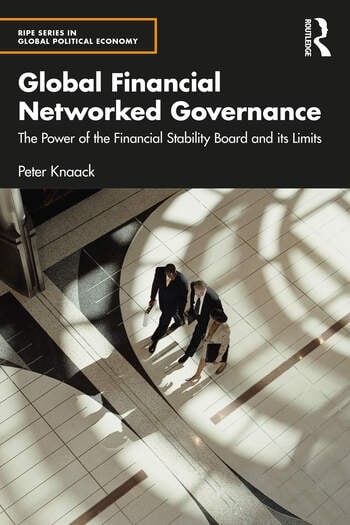Book Review - Global Financial Networked Governance: The Power of the Financial Stability Board and its Limits

Global Financial Networked Governance: The Power of the Financial Stability Board and its Limits, by Peter Knaack. Abingdon and New York: Routledge, 2023. 224 pp., £120 hardcover 9781032268057, £34.99 paperback 9781032268071
This book critically examines the achievements (and, sometimes, the lack thereof) of the Financial Stability Board (FSB), which was established by the Group of Twenty (G20) in the wake of the Great Financial Crisis. With hyperbole, the FSB was described by US Treasury Minister Geithner as a novel ‘fourth pillar’ of the global economic architecture, alongside the International Monetary Fund (IMF), the World Bank, and the World Trade Organisation. The FSB can directly issue international standards (i.e. soft law that is not legally binding) or can parcel out work to other international standard-setting bodies. It also monitors the implementation of international financial standards in its member jurisdictions.
The FSB brings together central bankers, financial regulators, and treasury ministry officials of the G20 jurisdictions, even though in the case of smaller G20 jurisdictions, only the national central bank is a member of the FSB. The FSB also includes representatives from other international standard-setting bodies in finance, such as the Basel Committee on Banking Supervision (BCBS), the Committee on Payments and Market Infrastructures (CPMI), the International Organisation of Securities Commissions (IOSCO), the International Association of Insurance Supervisors (IAIS), as well as the Bank for International Settlements, the World Bank and the IMF. The FSB played a crucial role in the post-crisis reforms of global financial governance after 2008.
 Global Financial Networked Governance begins with an intriguing puzzle: whereas, on certain issues, the FSB has had an excellent track record in setting standards and subsequently ensuring their domestic implementation, it has been less successful in other policy areas. What accounts for its uneven performance?
Global Financial Networked Governance begins with an intriguing puzzle: whereas, on certain issues, the FSB has had an excellent track record in setting standards and subsequently ensuring their domestic implementation, it has been less successful in other policy areas. What accounts for its uneven performance?
Peter Knaack argues that the main explanation of the FSB’s success and failures has to do with ‘institutional pathways of policy-making’, that is to say, the degree of involvement of transgovernmental networks of ‘technical’ financial regulators and elected officials in parliament. Specifically, whereas national regulatory agencies composed of unelected officials (i.e. financial regulators) are relatively effective in cross-border cooperation in standard setting and subsequent domestic implementation, national legislatures are inward-oriented and often pose hindrances to the global governance of finance. The author also considers some alternative explanations, such as the preferences of the main jurisdictions on a given issue; the distributional implications (i.e. the costs and benefits) of certain international standards across countries; business power, that is, the influence of the financial industry and the domestic political salience of financial regulation.
The book examines three important case studies. The first case is the implementation of the Basel III accord, which sets capital and liquidity requirements for internationally active banks. To be sure, this international banking standard was issued by the BCBS (not the FSB) and domestic compliance with this soft law was also monitored by the BCBS. Yet, the BCBS, like the FSB, is an example of an international technocratic network, as opposed to politicians sitting in national legislatures. The second case study analysed by the book concerns over-the-counter derivatives, with a specific focus on derivatives trade reporting, a matter on which the FSB (belatedly) took the lead. The third case has to do with international rules for the resilience and resolution of Globally Systemically Important Banks, in order to deal with the problems of banks that are too big to fail, but also too big to be rescued. These cases are examined through processing tracing, complemented by several semi-structured elite interviews with policy-makers in various jurisdictions.
The book has many strengths. To begin with, it is well-researched and well-written. It makes very good use of visuals to help the reader follow the ‘plot’ of what are necessarily rather technical and complex issues. Moreover, some great interview quotes enliven what could potentially be a somewhat ‘dry’ text. These interviews also provide interesting insights into the internal functioning of the FSB as well as the views of various participants involved in the policy process of post-crisis financial regulatory reforms. And we do not just hear from the ‘usual suspects’, that is to say, policymakers in the United States and Europe, because the author also reached out to policymakers in the Global South. The second strength of the book is its solid theoretical underpinning with a view to deriving explanations that could travel to other policy areas and other international standard setters. In the realm of finance, one obvious case would be shadow banking, an issue that was dealt with by the FSB with somewhat mixed results. To be sure, shadow banking is discussed in parts of the book, but not in a systematic way. It is a sort of shadow case (please forgive my wordplay).
The book raises several interesting questions for the attentive reader. For one thing, does the number of international standard setters involved in a given policy area make a difference in determining the success (or otherwise) of international regulatory efforts? The most successful cases of post-crisis regulatory reforms presented in the book are international standards that were issued only by one international standard-setting body - namely, the BCBS in the case of Basel III and the FSB in the case of Loss Absorbing Capacity for Globally Systemically Important Banks. In the case of financial derivatives, international standards were slow to emerge also because a multiplicity of international standard setters in finance were involved, namely, the FSB, the BCBS, the IOSCO, the CPMI, as well as private standard setters, also outside finance, such as the International Accounting Standard Board and the International Organization for Standardization. Shadow banking, like derivatives, was an international ‘regime complex’, characterized by the presence of multiple institutions and elemental regimes governing a set of related issues (Quaglia, Lucia, The Perils of International Regime Complexity in Shadow Banking, Oxford University Press, 2022).
This monograph makes great reading for scholars and practitioners interested in the governance of global finance and international cooperation more generally. It explains why it is so difficult to agree first and implement later international rules designed to promote the resilience of the financial system as well as financial stability.
Lucia Quaglia is Professor of Political Science at the University of Bologna.


